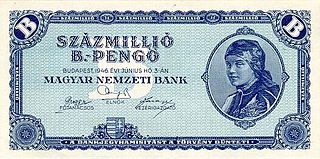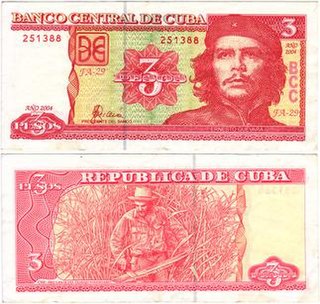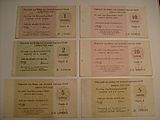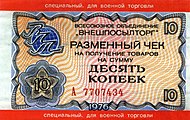A currency is a standardization of money in any form, in use or circulation as a medium of exchange, for example banknotes and coins. A more general definition is that a currency is a system of money in common use within a specific environment over time, especially for people in a nation state. Under this definition, the British Pound sterling (£), euros (€), Japanese yen (¥), and U.S. dollars (US$) are examples of (government-issued) fiat currencies. Currencies may act as stores of value and be traded between nations in foreign exchange markets, which determine the relative values of the different currencies. Currencies in this sense are either chosen by users or decreed by governments, and each type has limited boundaries of acceptance; i.e., legal tender laws may require a particular unit of account for payments to government agencies.

In economics, hyperinflation is a very high and typically accelerating inflation. It quickly erodes the real value of the local currency, as the prices of all goods increase. This causes people to minimize their holdings in that currency as they usually switch to more stable foreign currencies. Effective capital controls and currency substitution ("dollarization") are the orthodox solutions to ending short-term hyperinflation; however there are significant social and economic costs to these policies. Ineffective implementations of these solutions often exacerbate the situation. Many governments choose to attempt to solve structural issues without resorting to those solutions, with the goal of bringing inflation down slowly while minimizing social costs of further economic shocks.

The renminbi, also known as the Chinese yuan, is the official currency of the People's Republic of China. The renminbi is issued by the People's Bank of China, the monetary authority of China. It is the world's fifth-most-traded currency as of April 2022.

Currency substitution is the use of a foreign currency in parallel to or instead of a domestic currency.

The ruble or rouble is the currency of the Russian Federation. The ruble is subdivided into 100 kopecks. It is used in Russia as well as in the parts of Ukraine under Russian military occupation and in Russian-occupied parts of Georgia.
In macroeconomics, hard currency, safe-haven currency, or strong currency is any globally traded currency that serves as a reliable and stable store of value. Factors contributing to a currency's hard status might include the stability and reliability of the respective state's legal and bureaucratic institutions, level of corruption, long-term stability of its purchasing power, the associated country's political and fiscal condition and outlook, and the policy posture of the issuing central bank.

The Cuban peso also known as moneda nacional, is the official currency of Cuba.
The Latvian ruble was the name of two currencies of Latvia: the Latvian ruble, in use from 1919 to 1922, and the second Latvian ruble, in use from 1992 to 1993.

The Transnistrian ruble is the currency of the internationally unrecognized state of Transnistria. It is divided into 100 kopecks.

The kyat is the currency of Myanmar (Burma). The typical notation for the kyat is "K" (singular) and "Ks." (plural), placed before the numerals followed by "/-". Amounts less than K. 1/- are typically denoted with the number of pyas following "-/".

The ruble or rouble was the currency of the Soviet Union. It was introduced in 1922 and replaced the Imperial Russian ruble. One ruble was divided into 100 kopecks. Soviet banknotes and coins were produced by the Federal State Unitary Enterprise in Moscow and Leningrad.

Pewex was a chain of hard-currency shops founded in 1972, during the Communist era in Poland that accepted payment only in United States dollars and other hard currencies, instead of the country's indigenous currency, the Złoty.
A linked exchange rate system is a type of exchange rate regime that pegs the exchange rate of one currency to another. It is the exchange rate system implemented in Hong Kong to stabilise the exchange rate between the Hong Kong dollar (HKD) and the United States dollar (USD). The Macao pataca (MOP) is similarly linked to the Hong Kong dollar.
Each "article" in this category is a collection of entries about several stamp issuers, presented in alphabetical order. The entries are formulated on the micro model and so provide summary information about all known issuers.

This is a survey of the postage stamps and postal history of Kazakhstan.
Chervonets is the traditional Russian name for large foreign and domestic gold coins. The name comes from the Russian term червонное золото, meaning 'red gold' – the old name of a high-grade gold type.

Tuzex was a series of state-run shops in Czechoslovakia from 1957 to 1992 which did not accept normal Czechoslovak koruna currency but only vouchers which could be purchased from banks using foreign currency. They supplied luxury items: local goods in short supply and in particular foreign goods. The Tuzex vouchers were effectively an unofficial parallel currency.

Beryozka or Beriozka was the common name of two chains of state-run retail stores in the Soviet Union that sold goods in exchange for foreign currency. Beriozkas sold luxury goods such as chocolate and caviar that were often unavailable or unaffordable in traditional Soviet markets and shops. Beryozka stores existed between 1964 and 1990, up to the point of the Soviet Union dissolution.
Russia's monetary reform of 1993 took place from 26 July to 7 August 1993.

The paper money of the Qing dynasty was periodically used alongside a bimetallic coinage system of copper-alloy cash coins and silver sycees; paper money was used during different periods of Chinese history under the Qing dynasty, having acquired experiences from the prior Song, Jin, Yuan, and Ming dynasties which adopted paper money but where uncontrolled printing led to hyperinflation. During the youngest days of the Qing dynasty paper money was used but this was quickly abolished as the government sought not to repeat history for a fourth time; however, under the reign of the Xianfeng Emperor, due to several large wars and rebellions, the Qing government was forced to issue paper money again.





















